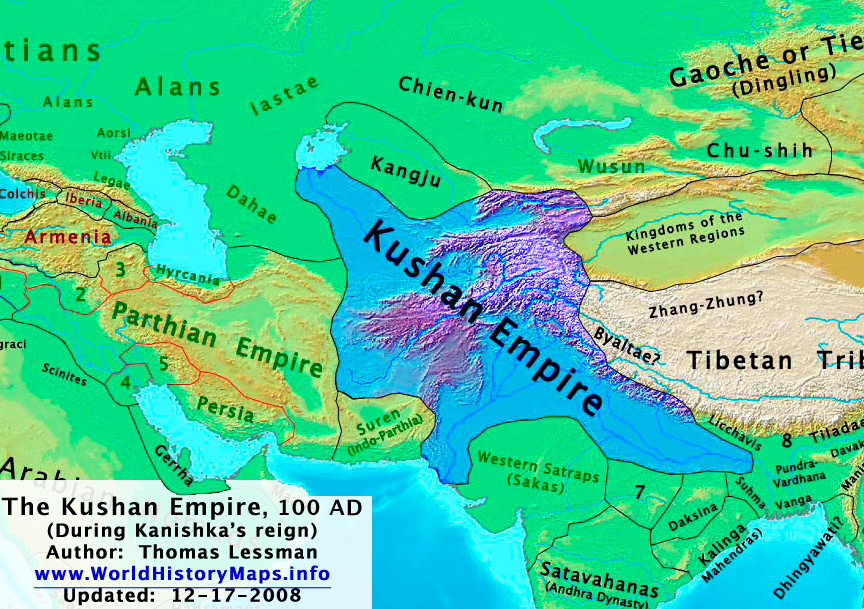https://www.worldhistorymaps.info/wp-content/uploads/2021/03/kushan-empire_100ad.jpg
The Kushan Empire (Ancient Greek: Βασιλεία Κοσσανῶν; Bactrian: Κυϸανο, Kushano; Late Brahmi Sanskrit: Gupta allahabad ku.jpg Gupta gujarat ssaa.jpg Gupta ashoka nn.svg, Ku-ṣā-ṇa; Devanagari Sanskrit: कुषाण राजवंश, Kuṣāṇa Rājavaṃśa; BHS: Guṣāṇa-vaṃśa; Parthian: 𐭊𐭅𐭔𐭍 𐭇𐭔𐭕𐭓, Kušan-xšaθr; Chinese: 貴霜) was a syncretic empire, formed by the Yuezhi, in the Bactrian territories in the early 1st century. It spread to encompass much of modern-day territory of Afghanistan, Pakistan and northern India, at least as far as Saketa and Sarnath near Varanasi (Benares), where inscriptions have been found dating to the era of the Kushan Emperor Kanishka the Great.
The Kushans were most probably one of five branches of the Yuezhi confederation, an Indo-European nomadic people of possible Tocharian origin, who migrated from northwestern China (Xinjiang and Gansu) and settled in ancient Bactria. The founder of the dynasty, Kujula Kadphises, followed Greek religious ideas and iconography after the Greco-Bactrian tradition, but was also a devotee of the Hindu God Shiva, an almost historical necessity due to the presence of Indian culture and traders on the Silk Road. The Kushans in general were also great patrons of Buddhism, and, starting with Emperor Kanishka, they also employed elements of Zoroastrianism in their pantheon. They played an important role in the spread of Buddhism to Central Asia and China.
The Kushans possibly used the Greek language initially for administrative purposes, but soon began to use the Bactrian language. Kanishka sent his armies north of the Karakoram mountains. A direct road from Gandhara to China remained under Kushan control for more than a century, encouraging travel across the Karakoram and facilitating the spread of Mahayana Buddhism to China. The Kushan dynasty had diplomatic contacts with the Roman Empire, Sasanian Persia, the Aksumite Empire and the Han dynasty of China. The Kushan Empire was at the center of trade relations between the Roman Empire and China: according to Alain Daniélou, “for a time, the Kushana Empire was the centerpoint of the major civilizations”. While much philosophy, art, and science was created within its borders, the only textual record of the empire’s history today comes from inscriptions and accounts in other languages, particularly Chinese.
The Kushan Empire fragmented into semi-independent kingdoms in the 3rd century AD, which fell to the Sasanians invading from the west, establishing the Kushano-Sasanian Kingdom in the areas of Sogdiana, Bactria and Gandhara. In the 4th century, the Guptas, an Indian dynasty also pressed from the east. The last of the Kushan and Kushano-Sasanian kingdoms were eventually overwhelmed by invaders from the north, known as the Kidarites, and then the Hephthalites.
Source: Wikipedia

